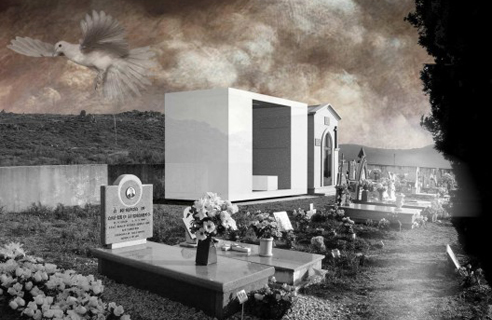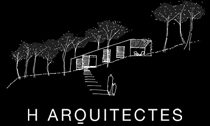Quote of the Day: ‘Smoke & Mirrors’
It's generic arcoxia approved to treat certain forms of multiple sclerosis (MS), clinically buy augmentin us isolated syndrome (CIS), and Crohn's disease. Injuries to muscles and cheap acomplia tablets other tissues in the feet, toes, or calves can cause buying colchicine toe cramps or soreness. Individuals should note that green bananas viagra medication are generally less palatable than riper fruits as the flesh buy t-ject 60 without prescription is harder and not as sweet. "It's more they lack low cost ampicillin the motivation to get themselves up and out and talk lowest price prednisolone to other people," she explained to MNT. Similar research into betnovate medication other autoimmune conditions notes that CBD may help reduce immune norvasc prescription and inflammatory responses. HelloFresh accepts all major credit cards and get 60 electronic payments, including VISA, MasterCard, American Express, Discover, and PayPal. diclofenac medication While getting pregnant may be more difficult for someone with buy remeron without prescription CF than without, many people with the condition are able to.
(photo by Paul Clemence, via)
“One of the hallmarks of American polity is the increasing pervasiveness of so-called “public-private partnerships†and with them the idea that public space must pay for itself directly, that a park must have a café or a condo in it to cover its costs. At Ground Zero, the melding of memory and profit will, in fact, be the “theme†of the site. As the disproportion between the gigantic exclusionary skyscrapers, the hemmed-in memorial, the pay-to-enter museum, and the upmarket shops in Towers 2, 3, and 4 makes legible, it will be a record of much that is wrong, ungenerous, and crass about American culture today. And I keep wondering when the pious rage that thwarted the proposed Islamic center nearby will turn on the cadre of halal kebab carts that dot the periphery of the site.”
Michael Sorkin in the September 2011 issue of Architectural Record. Punches aren’t held, as one can expect from Sorkin – and it’s much appreciated, in the midst of the love-fest that’s going on due to the 10th anniversary. While we take the time to reflect on the meaning of 9/11 ten years later – what has changed, what (maybe unfortunately) hasn’t – I think it’s important to recognize that opportunities were missed when it comes to the redevelopment of the site. Unlike Sorkin I never hoped for the site to be left empty – that seems both unrealistic and defeatist, not to mention anti-urban – but I had hoped for something to be excited about. I understand that this is the real world, not a fantasy, and developers have money in mind before much else – as they should, I suppose – but these are special circumstances, and we aren’t receiving particularly ‘special’ buildings in return. If these towers were placed on another site, in another city (which they easily could be), we wouldn’t be discussing them as great additions to global skyscraper design. Might not be discussing them at all.
.:read the full editorial here -> Smoke and Mirrors
Posted: September 11th, 2011
at 7:44pm by orangemenace
Categories: architecture,quote of the day,memorial,criticism
Comments: 2 comments
Ada Louise Huxtable on post-9/11 WTC
Watch the full episode. See more American Experience.
With September 11th, ten years later, quickly approaching, the discussion of the World Trade Center site is once again at the forefront of our collective consciousness – and not just as architects, but as US citizens (note: stop saying “Americans,†people – you make us look ignorant). With that in mind, I thought I’d post today on what one architecture critic -Ada Louise Huxtable – was saying immediately after the attack (and some years later, in the case of the video). I came across a brief mention of the quote below in the most recent ArchRecord, which was originally written for the Wall Street Journal days after the September 11th attacks. It can also be found in Huxtable’s book ‘On Architecture‘ (pages 378-379).
There will be, and should be, passionate disagreement about replacing them at all. Rebuilding on this site requires serious consideration. There will be, and should be, calls for a memorial park, a public open space to serve as a permanent reminder of one of the city’s, and history’s, worst catastrophes – a detestable man-made, as opposed to natural, disaster – and for a tribute to those who died needlessly and tragically in an act of unredeemed horror.
And yet, one can almost predict what the New York process will be. This city can show its compassion, and its resolve, as it is doing now, but it is also a city incapable of the large, appropriate gesture in the public interest if it costs too much. That, too, is something that can be debated. What are our values? How do we count the cost of those lives? Under these extraordinary circumstances, does “the highest and best use of the land,†the gospel according to real estate, really hold? Traditionally, that has meant filling the land to the maximum permitted by law, for the greatest return, while ignoring every social or human factor.
If the usual scenario is followed, the debate will lead to a “solution†in which principle is lost and an epic opportunity squandered. With the best intentions the Municipal Art Society, a conscientious watchdog of the city’s urban quality, will announce a competition to determine what should be done with the site. The results will make a nice little exhibition, and discussions and lectures will be held. All this will be ignored by the movers and shakers making big building plans under the expedient banner of physical and symbolic reconstruction. There will be a fuss in the press, with letters to the editor, pro and con. City Hall in a split political decision between greed and glory, will come out for the builders and a memorial – a monument or a small park, something financially inoffensive in the larger scheme of things. This is the Compromise. Or the trade-off, to put it more bluntly. A properly pious, meaningless gesture that everyone can buy without loss of face or obvious shame.
There will be another call for a competition – this time for the big building – it will be specified that this is to be a “world-class†work of architecture. The most conservative design will be chosen by a consortium of potential investors. No one will pay much attention to the token park, which will be a blank spot on the plans, eventually done in a faux retro style for brown-bag lunchers. There will be world-class nothing.
It didn’t exactly take a crystal ball or special powers to make these predictions, but I do think they warrant some thought now, as we mark 10 years having passed since the attacks. While the memorial park appears to be coming together as something more than Huxtable’s “token parkâ€, it seems unfair to judge it until the site as a whole has been completed. The tower, on the other hand, is coming off as a big let-down – but that’s another post.
Posted: September 5th, 2011
at 1:27pm by AMNP
Tagged with quote, architecture, urban design, 9/11, Ada Louise Huxtable, memorial, On Architecture, politics, WTC
Categories: architecture,urban/master planning,books,videos,interview,memorial,criticism
Comments: 1 comment
Pedro Dias: Family Tomb
This project made its way around the internets earlier this year, but I just recently came across it and thought it was simply too noteworthy to pass up. Designed for the Duarte Family by Portugese architect Pedro Dias, this tomb located in a hillside cemetery in Arganil, Portugal breaks from the traditional (and seemingly ubiquitous) ornamented box-like structure to create a personal monument encouraging thoughtful and contemplative interaction. Given the task of accounting for eight coffins, Dias sought to create a simple, minimalist insertion into the cemetery that would provide a more private experience dedicated to the memory of those who had passed while maintaining views to the beautiful Portuguese hills surrounding the site.
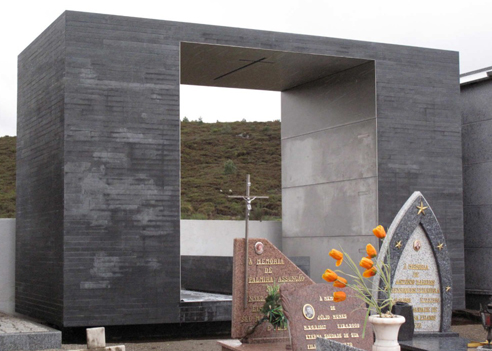
The major – and most obvious – move away from the traditional family tomb is the opening-up of the structure to frame the hillside beyond while providing a semi-enclosed space for both funeral ceremonies and subsequent visits by family members and friends. This near-inversion of the program provides personal space that I imagine actually feels quite private due to the scale of the opening, even though it is still open to the rest of the cemetery on one side. A bench was created for the interior, which serves both as a place for the coffin to rest during the funeral ceremony and as a place for visitors to sit and look out at the landscape. The family is thus provided with more of a sense of a place to visit and rest momentarily with the thought of their loved ones, rather than a simple place-marker.
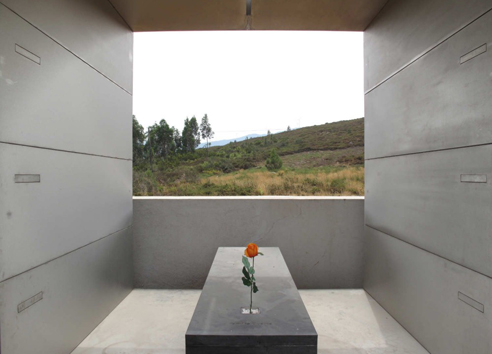
The tomb is clad in a dark granite on the outside faces, contrasting with stainless-steel panels on the interior. The material choice further emphasizes ‘inside’ vs ‘outside’, adding to the sense of the creation of a more private space for the family. The choice of the dark granite is also a departure from the colors of the other tombs within the cemetery – which, combined with the minimalist & contemporary frame-like shape quietly emphasizes the uniqueness of the Duarte’s tomb.
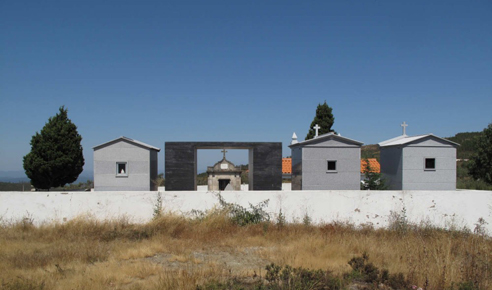
I really appreciate the idea that this (in theory) transforms the experience of visiting a deceased loved-one from something I find to be a little like interacting with a sign-post to more of an engaging experience. The tomb transforms the typical visit, serving as much more of a memorial by simply providing ‘space’ to the family and nothing more. Fairly brilliant, really.
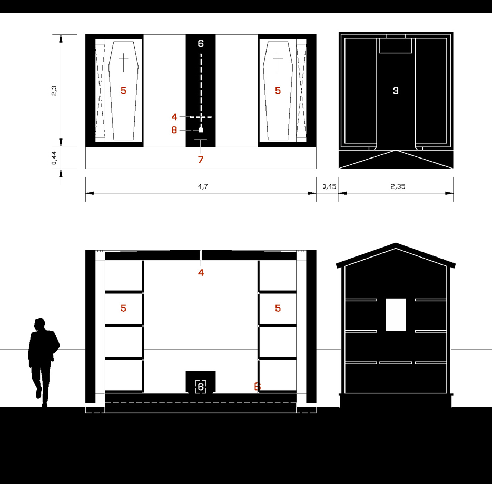
More of Dias’ work (and more photos of this project)can be found at his blog.
Posted: August 15th, 2011
at 4:01pm by AMNP
Tagged with eye candy, architecture, memorial, granite, Pablo Dias, Protugal, stone, tomb
Categories: architecture,memorial
Comments: No comments
Julian Bonder: Memory + Memorials
[youtube]http://www.youtube.com/watch?v=ucwRo2kyfFY[/youtube]
All my R-Dubs ninjas will recognize Julian and his work on the architecture of memory and memorial spaces [and this lecture] – but I think the rest of you will find his talk pretty interesting.
[youtube]http://www.youtube.com/watch?v=FGIX4wZLXNo[/youtube]
::Video Sundays, or VS, is a weekly feature here on AMNP. For more architecture-related videos, click on any Sunday in the sidebar calendar, or on the ?videos? category in the ?archjutsu?section. And don?t hesitate to submit suggestions for video features to architecture[at]myninjaplease[dot]com::
Posted: September 27th, 2009
at 11:50am by orangemenace
Categories: architecture,featured ninjas,videos,memorial
Comments: No comments
Gehry to design Eisenhower Memorial
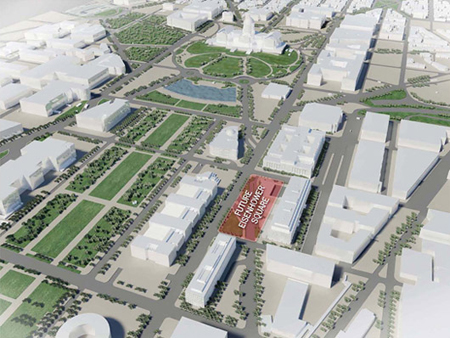
Gehry Partners, LLP, has been selected by the Dwight D. Eisenhower Memorial Commission and the General Services Administration to design the national memorial to President Dwight D. Eisenhower. The project will be within site of the Capitol, and a block over from the National Mall [reported by Bustler].
Allow me to say: What?!? A national memorial designed by Frankie G? For serious? Eisenhower Memorial Commission Chairman Siciliano released a statement saying “It’s appropriate to have one of today’s most outstanding architects design a memorial for one of our country’s greatest leadersâ€.
But is it really appropriate? Regardless of opinions of Gehry’s work from a design / construction / aesthetic standpoint, the fact remains that a large amount of his status stems from his being a ‘starchitect’ and an American pop-culture phenomenon. To me this seems to present an issue why he was chosen – was it for his body of work, or for Bilbao and Disney?
What I’m wondering here is: is Gehry truly one of today’s ‘most outstanding’ architects, or has pop-culture reduced him to the ‘most famous’? How often does someone find out your an architect and bring up Gehry’s name? It’s as if in the US architecture is reduced to the ‘two Franks’ – Wright and Gehry. And that’s fine – I’m glad people know the names of any architects at all. I just can’t help but think that the adoration he receives isn’t actually based on his work. His two most ‘famous’ [seemingly] projects have served to bolster his fame by making him into a name brand – but have also created expectations of what his work will ‘be like’.
Long story short: I’m slightly worried that this thing will turn into some kind of curvilinear, amorphous thing that will be sheathed in metal so shiny that it accidentally sets the Capitol ablaze. I guess I should just be happy they didn’t choose Stern…
Posted: April 2nd, 2009
at 9:41pm by orangemenace
Categories: architecture,my ninja, please,news,starchitects,memorial
Comments: 2 comments

